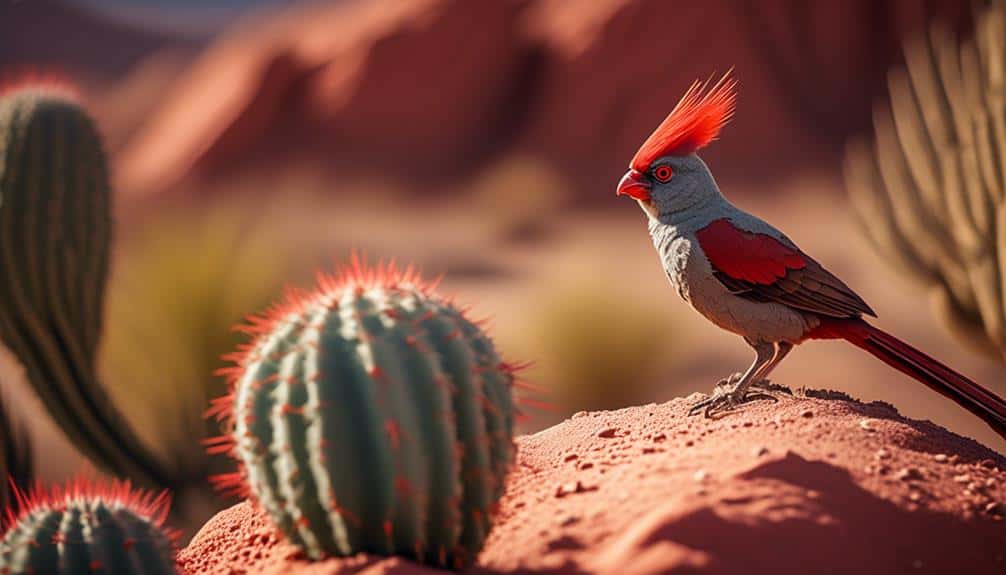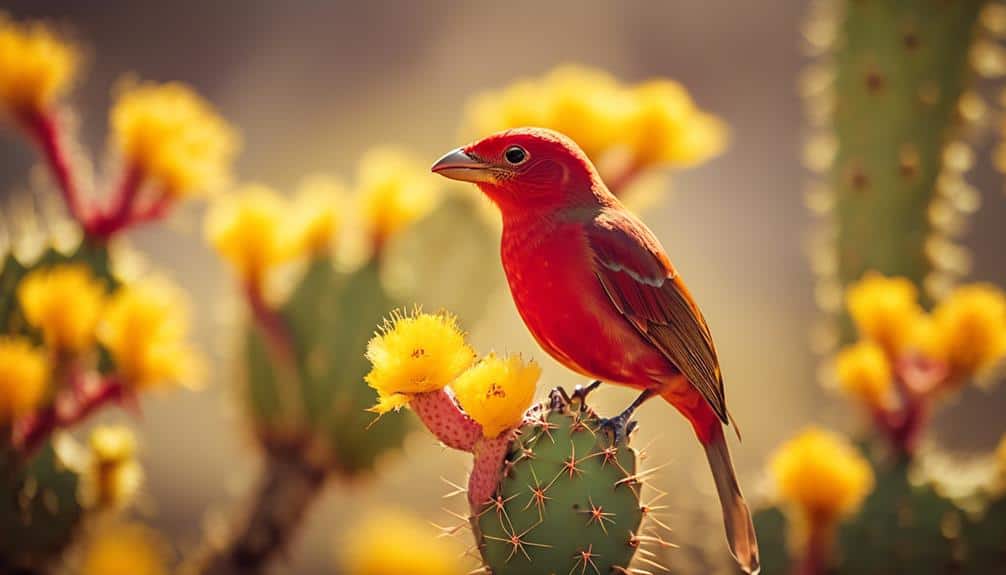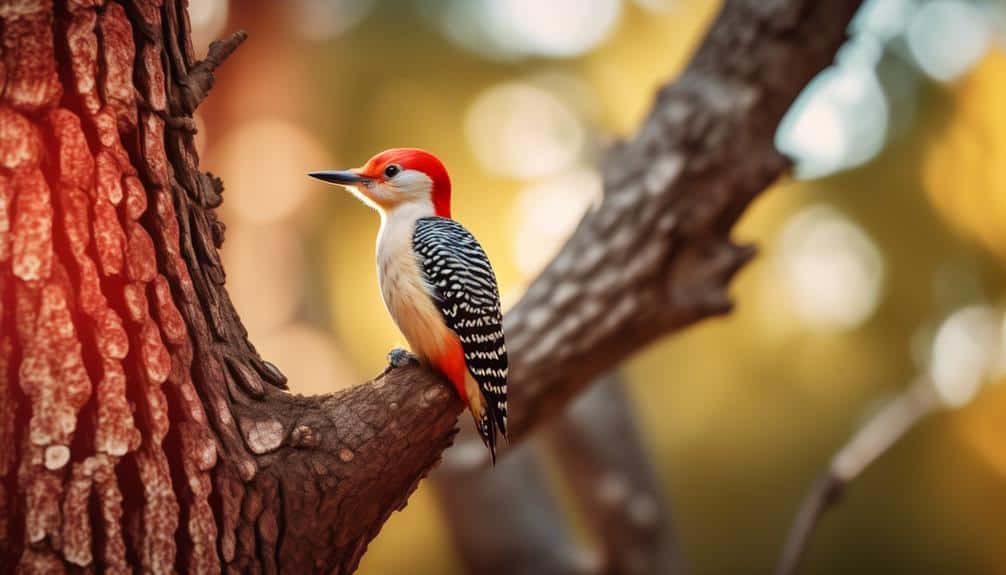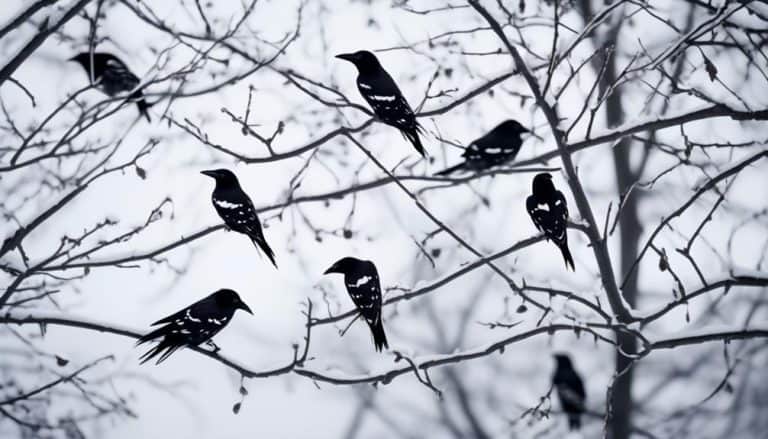As I stood amidst the sprawling Texan landscape, the sight of red birds was as common as the sun setting over the horizon. These crimson creatures, like flickering flames, added a captivating touch to the vast expanse of nature.
However, what intrigued me the most was not just their vibrant hue, but the diverse species that called Texas their home. From the iconic Northern Cardinal to the elusive Vermilion Flycatcher, each red bird had its own unique story to tell.
As I embarked on a journey to uncover the secrets of these captivating creatures, little did I know that I was about to witness a world of wonder and mystery unfold before my eyes.
Northern Cardinal: A Texan Icon

The Northern Cardinal, a vibrant red bird native to Texas, has become a beloved icon of the Lone Star State. Its distinctive red plumage and melodic song make it a popular sight in gardens, parks, and woodlands across the region. When considering the northern cardinal's habitat, it's important to note that it prefers a variety of habitats including forests, shrublands, and residential areas with dense vegetation. It's commonly found in Texas, as it thrives in the state's warm climate and diverse landscapes.
As for the northern cardinal's diet, it primarily feeds on seeds, fruits, and insects. Its strong, cone-shaped beak allows it to crack open tough shells and extract the nutritious seeds inside. In the summer months, the northern cardinal's diet expands to include a wider range of insects, such as beetles, grasshoppers, and spiders. This diverse diet ensures that the bird receives the necessary nutrients to maintain its vibrant plumage and energetic lifestyle.
Vermilion Flycatcher: The Elusive Red Jewel

Having explored the habitat and diet of the Northern Cardinal, it is now time to turn our attention to the Vermilion Flycatcher, a captivating red jewel that eludes easy detection. The Vermilion Flycatcher (Pyrocephalus rubinus) is a small passerine bird found in the southwestern United States, including Texas. With its striking red plumage, the male Vermilion Flycatcher is a sight to behold. However, locating this elusive bird can be quite challenging due to its secretive nature and preference for dense vegetation.
One interesting aspect of the Vermilion Flycatcher's life is its breeding habits. These birds are known for their elaborate courtship displays, in which the male performs aerial acrobatics and sings melodious songs to attract a mate. They construct cup-shaped nests in shrubs or trees, usually near a reliable food source. The female lays 2-4 eggs, which she incubates for about two weeks. Both parents take turns feeding and caring for the chicks until they fledge after about two weeks.
In terms of migration patterns, the Vermilion Flycatcher is considered a partial migrant. While some populations are resident and stay in their breeding grounds year-round, others undertake seasonal migrations to warmer regions. These migratory movements are influenced by factors such as food availability and weather conditions.
To provide a visual representation of the Vermilion Flycatcher's breeding habits and migration patterns, let's take a look at the table below:
| Aspect | Breeding Habits | Migration Patterns |
|---|---|---|
| Courtship Display | Elaborate aerial acrobatics and melodious songs | N/A |
| Nest Construction | Cup-shaped nests in shrubs or trees | N/A |
| Incubation Period | Approximately two weeks | N/A |
| Number of Eggs | 2-4 | N/A |
| Migratory Behavior | Partial migrant | Some populations undertake migration |
Pyrrhuloxia: The Desert Cardinal of Texas

The Pyrrhuloxia, known as the Desert Cardinal of Texas, is a distinctive bird species found in the arid regions of the southwestern United States. This desert bird is known for its unique plumage, which sets it apart from its vibrant red cousin, the Vermilion Flycatcher. Here are four remarkable features of the Pyrrhuloxia that evoke a sense of awe and fascination:
- Plumage: The Pyrrhuloxia boasts a striking combination of gray and reddish-brown feathers. The male displays a vibrant red crest on its head, contrasting with its gray body and wings. The female, on the other hand, exhibits a more subdued coloration, with a pale gray overall appearance.
- Beak: One of the most distinctive features of the Pyrrhuloxia is its powerful, stout beak. Adapted to its arid habitat, this beak allows the bird to crack open tough desert seeds and extract their contents with ease.
- Adaptability: The Pyrrhuloxia is well-suited to survive in the harsh desert environment. With its ability to thrive on a diet primarily composed of seeds, it has successfully adapted to the scarcity of water and food.
- Vocalizations: The Pyrrhuloxia's song is a unique combination of whistles and metallic notes, which can be heard echoing through the desert landscape. This distinctive vocalization adds to the bird's allure and serves as a means of communication within its desert community.
The Pyrrhuloxia's desert habitat and unique plumage make it a captivating species, showcasing the remarkable adaptations of wildlife to survive in extreme environments.
Scarlet Tanager: A Vibrant Visitor in the Spring

Arriving with the vibrant colors of spring, the Scarlet Tanager graces us with its brilliant plumage and melodic song. This stunning bird, often mistaken for a tropical species, is a common sight in Texas during its migratory period. With its vibrant plumage, the male Scarlet Tanager stands out among the foliage, displaying a striking combination of bright red plumage and jet-black wings. The female, on the other hand, exhibits a more subdued olive-green color, blending in with the surrounding vegetation.
During the spring months, Scarlet Tanagers embark on a remarkable journey from their wintering grounds in South America to their breeding grounds in North America. These migratory patterns allow birdwatchers in Texas the opportunity to witness the beauty of these vibrant visitors. As they make their way across the continent, Scarlet Tanagers rely on a variety of habitats, including forests and woodlands, where they forage for insects and fruit.
To further illustrate the migratory patterns of the Scarlet Tanager, the following table provides a visual representation of their breeding and wintering locations:
| Season | Breeding Location | Wintering Location |
|---|---|---|
| Spring/Summer | North America | South America |
Observing the Scarlet Tanager in its natural habitat is truly a remarkable experience. Its vibrant plumage and melodious song make it a true symbol of the arrival of spring in Texas.
Summer Tanager: Texas' Scarlet Songbird

As the Scarlet Tanager bids farewell to Texas, another vibrant songbird takes its place – the Summer Tanager, a striking red bird that graces the Lone Star State with its melodious tunes.
Here are four fascinating facts about the Summer Tanager that will surely evoke wonder and admiration:
- Breeding Habits: The Summer Tanager is known for its unique breeding habits. Unlike most songbirds, the female Summer Tanager takes the lead in courtship. She displays an impressive array of behaviors, including wing-fluttering, tail-flicking, and vocalizations, to attract a mate. Once a pair forms, they build a cup-shaped nest using twigs, grass, and other plant materials.
- Migration Patterns: The Summer Tanager is a neotropical migrant, spending its winters in Mexico, Central America, and South America. In the spring, these vibrant songbirds embark on an incredible journey, crossing the Gulf of Mexico to reach their breeding grounds in Texas and other parts of the southern United States. Their arrival heralds the arrival of summer.
- Vocalizations: The male Summer Tanager is renowned for its beautiful and distinctive song. Its melodious tunes, consisting of a series of clear, whistling notes, can be heard echoing through the forests and woodlands where they reside. These songs serve multiple purposes, including defending territory and attracting a mate.
- Plumage: The Summer Tanager boasts vibrant plumage, with the males sporting a brilliant red coloration that stands out against the green foliage. The females, on the other hand, exhibit a more subdued yellow-green color, providing excellent camouflage for nesting. These striking differences in plumage between the sexes are known as sexual dimorphism.
Red-bellied Woodpecker: A Flash of Red in the Trees

Spotting a flash of red among the trees, one can easily identify the presence of the Red-bellied Woodpecker in its habitat. This striking bird, known scientifically as Melanerpes carolinus, is a common sight for birdwatchers in Texas. With its vibrant red crown and nape, the Red-bellied Woodpecker stands out against the green foliage of the trees. Its name, however, can be misleading, as the red on its belly is often obscured by its white or pale-colored underparts.
The Red-bellied Woodpecker is approximately 9-10 inches in length and has a wingspan of about 13-17 inches. Its body is predominantly black, with a white or cream-colored breast and a black and white barred back. Its bill is long, sturdy, and slightly curved, allowing it to easily chisel into tree trunks in search of insects and larvae.
This woodpecker is highly adaptable and can be found in a variety of wooded habitats, including forests, woodlands, parks, and suburban areas. It's known for its distinctive call, a rolling 'churr' or 'churr-churr' sound, which can often be heard echoing through the trees.
During nesting season, the male Red-bellied Woodpecker will drum on trees to establish its territory and attract a mate. It excavates cavities in dead or decaying trees, creating a nest hole for its eggs. Both parents take turns incubating the eggs and caring for the hatchlings.
Frequently Asked Questions
What Is the Scientific Name of the Northern Cardinal?
The scientific name of the northern cardinal is Cardinalis cardinalis. This species is commonly known for its vibrant red plumage and distinctive crest. It is a popular bird species found in various regions of North America.
How Does the Vermilion Flycatcher Differ From the Northern Cardinal in Terms of Appearance and Behavior?
When it comes to the vermilion flycatcher and the northern cardinal, their appearances and behaviors are as different as day and night. Let's delve into their contrasting traits and how they contribute to the ecosystem.
Are Pyrrhuloxias Only Found in Desert Regions of Texas?
No, pyrrhuloxias are not only found in desert regions of Texas. They can also be found in other habitats such as grasslands and scrublands. Their diet consists of seeds, fruits, and insects.
What Other Bird Species Can Be Commonly Seen Alongside Scarlet Tanagers During Their Spring Migration?
During the spring migration, I often observe a variety of bird species alongside scarlet tanagers. It's fascinating to see the diverse mix of birds that travel together, creating a vibrant tapestry of colors and sounds.
How Does the Summer Tanager's Song Differ From the Calls of Other Texas Songbirds?
The summer tanager's song differs from other Texas songbirds with its melodic and rich notes. It resonates through the open wooded areas of its breeding habitat in the southern United States, Mexico, Central America, and northern South America.
Conclusion
In conclusion, the red birds of Texas are a diverse and visually striking group of species. From the iconic Northern Cardinal to the elusive Vermilion Flycatcher, each bird brings its own unique beauty to the Texas landscape.
Through careful observation and scientific investigation, we can better understand the behavior and ecology of these red birds, providing a visual representation of their importance in the natural world.







